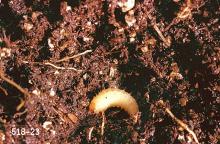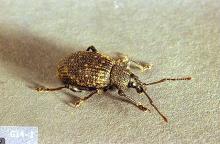Including
Black vine weevil (Otiorhynchus sulcatus)
Pest description and crop damage Adult weevils are black, 0.4 inch long, and appear May through July. Larvae are C-shaped, legless, and white with tan heads, up to 0.5 inch in size. Adult weevils cause a characteristic notching in the leaves of host plants. This feeding damage is relatively minor. The real damage is done by the larvae, which feed through the winter and spring on the root systems of host plants. Infested plants are stunted, grow poorly, and may die.
Biology and life history Weevils overwinter as larvae in the soil. Feeding may occur throughout mild winters. In April to June, larvae pupate, and adult emergence occurs. Adults are night feeders that remain in the soil or in debris at the base of the plant during the day, then climb up to feed on leaves. Adult weevils cannot fly, but walk or are carried from one location to another. Also, all adults are females capable of laying eggs. Adults are slow moving and should not be confused with swifter predacious ground beetles. Eggs are laid in clusters in or on the soil from June to September. The eggs hatch and the larvae immediately wriggle through the soil to begin feeding. There is one generation per year.
Scouting and thresholds Observe leaves for first signs of notching in early summer (primroses are an inexpensive preferred host and can be used as an indicator plant for conifer field production. Confirm the presence of adults by night inspection of foliage on warm, still evenings. Or, look for adults by day in debris at the base of the plant. Laying a small piece of cardboard at the base of the plant provides a refuge that you can check easily in the early morning. Commercial root weevil traps are available.
Management-biological control (larvae)
Natural enemies include:
- carabid (ground) beetles several species
- pathogenic nematodes (Heterorhabditis heliothidis, H. medidis, Steinernema carpocapsae, S. feltiae, S. kraussei, S. riobravis)-Adequate soil moisture and temperature are necessary for success.
Management-chemical control
- abamectin (Aracinate) at 5 mL per 2 inches of cumulative trunk diameter at 4.5 ft above the ground.
- acephate (Orthene TR, Precise) at 0.024 lb ai/1,000 sq ft broadcast (0.6 oz). REI 24 hr.
- acetamiprid (Tristar 30SG) at 0.81 to 1.59 oz ai/100 gal. REI 12 hr.
- azadirachtin (Azahar, Azatin XL)-Some formulations are OMRI-listed for organic use.
- Bacillus thuringiensis (grubGONE!, beetleGONE!)-Do not apply more than 6 lb 14 oz of product per 1000 sq ft per year.
- Beauveria bassiana (Botanigard, Mycotrol, Nautralis L)-Some formulations are OMRI-listed for organic use.
- beta-cyfluthrin (Tempo Ultra GC) at 45 to 160 ml/100 gal water.
- bifenthrin (Talstar S) at 0.168 to 0.335 lb ai/1,000 sq ft. REI 12 hr. Restricted use pesticide.
- Burkholderia spp. (Venerate CG)-Rate depends on application type.
- canola oil (Mighty)-Do not apply more than 2.5 gal per 100 sq ft per application. Do not reapply within 3 days.
- capsaicin (Prevasyn) at 0.5 to 1 tsp/gal water to cover 350 sq ft.
- carbaryl (Sevin)-Application depends on specific host.
- chlorantraniliprole (Acelepryn) at 0.0625 to 0.25 fl oz (0.00082 to 0.0033 lb ai) per inch DBH of tree or per foot height of shrub.
- chlorpyrifos (Vulcan) at 1/12 to 1/6 fl oz per gal on 0.5 to 1 pint per 100 gal, no more than 2.8 quarts per acre/year.
- Chromobacterium (Grandevo)-Application rates based on host plant.
- cinnamon oil (Gargoil)-Apply 1 to 2 quarts per acre, depending on pressure, in a minimum of 50 gal water.
- clothianidin (Arena 0.25G)-Only apply to moist soil, rates vary by height and DBG (trees).
- cottonseed oil, peppermint oil, geraniol, rosemary oil (Furious) at 22 to 33 fl oz/A or 3 fl oz/gal for 1,000 sq ft. WA only.
- cryolite (Gowan Cryolite Bait) at 0.5 to 1.5 lb per 1,000 sq ft.
- cyantraniliprole (Mainspring) at 12 to 20 fl oz per acre for bluegrass weevil.
- cyclaniliprole/flonicamid (Pradia) at 10 to 17.5 fl oz/100 gal.
- cyfluthrin/imidacloprid (Discus N/G) at 0.063 lb ai/100 gal foliar; 0.009 to 0.014 lb ai/1,000 ft soil. REI 12 hr.
- cyhalothrin (Scion) at 0.16 to 0.33 fl oz/gal water or 0.5 to 1.0 fl oz/3 gal water
- DDVP (nuvan fog 5%)-Use is prohibited on food plants
- deltamethrin (D-Fense Dust) at 8 oz product per 1,000 sq ft or as a thin layer.
- diatomaceous earth (PermaGuard)-Minimum 1 lb to 2 gal water; max 1 lb to 25 gal water.
- diazinon-Various formulations, refer to label for application rates.
- diflubenzuron (Dimilin, Diflumax)-Apply at a rate of 8 to 16 oz per 100 gal water when adult weevils are present and/or to newly expanded growth. Will not control adult weevils but will reduce the reproductive potential of adult weevils, resulting in decreased egg hatch.
- dimethoate (dimethoate 400 EC)-Varies by host, see label for application rates.
- dinotefuran (Safari 20SG) at 0.1 to 0.2 lb ai/1,000 ft sq; 0.05 to 0.1 lb ai/100 gal. REI 12 hr.
- fenpropathrin (Valent Tame 2) at 10.33 fl oz/100 gal/A.
- flupyradifurone (Altus) at 2.8 to 3.7 fl oz/100 gal.
- imidacloprid (Marathon) at 0.027 oz ai /100 gal foliar. REI 12 hr. Drench and irrigation permitted.
- indoxacarb (Provaunt)-Labelled for use in WA only
- Isaria fumosoroseus (PFR 97) at 4 to 8 fl oz per pot as soil treatment. REI 4 hr. Some formulations are OMRI-listed for organic use.
- kaolin (Novasource) at 6.25 to 37.5 lb/A. Suppression only.
- lambda-cyhalothrin (Cyonara 9.7) at 1.5 to 5 fl. oz per 100 gal. or 44 to 148 mL per 100 gal.
- malathion (Fyfanon) at 2.5 lb ai/100 gal; max 2 applications per year, 10-day min retreatment interval.
- Metarhizium anisopliae (Met52G) at 1.5 to 3.0 lb product per cubic yard growing medium.
- naled (Dibrom 8)-Application varies by application type and crop
- neem oil (EcoWorks)-Low use: 1 pint/A; Mid use: 2 pints/A; High use: 4 pints/A. Repeat 7-14 days.
- novaluron (Rimon 0.83EC)-For container-grown ornamentals in greenhouses, shade houses and outdoor nurseries.
- permethrin (Permethrin 3.2 AG)-Restricted use pesticide.
- phosmet (Imidan) at 0.75 to 1 lb (0.5 to 0.7 lb ai) per 100 gal.
- phosphine (Eco2Fume Gas)-Application rate dependant on ambient temperature.
- piperonyl butoxide (Evergreen Pro, Pest Xpert, Pyrenone Crop Spray)-Many products, see labels for application rates.
- pyrethrins (Lynx EC 1.4) at 16 fl oz to 64 oz/A
- pyridiben (Sanmite) at 6.4 to 9.6 oz/A -or- 0.15 to 0.22 oz per 1,000 sq ft.
- spinosad (Entrust) at 0.047 to 0.078 lb ai/100 gal. OMRI-listed for organic use.
- tau-fluvalinate (Mavrik Aquaflow) at 4 to 10 fl oz per 100 gal.
- thiamethoxam (Flagship 25WP) at 8 oz/100 gal or 17 oz/A.
- trichlorton (Dylox 420 SL) at 5.2 to 6.9 fl oz per 1,000 sq ft (225 to 300 fl oz per acre).




